
Ayrshire is a historic county and registration county, in south-west Scotland, located on the shores of the Firth of Clyde. The lieutenancy area of Ayrshire and Arran covers the entirety of the historic county as well as the island of Arran, formerly part of the historic county of Buteshire. Its principal towns include Ayr, Kilmarnock and Irvine and it borders the counties of Renfrewshire and Lanarkshire to the north-east, Dumfriesshire to the south-east, and Kirkcudbrightshire and Wigtownshire to the south. Like many other counties of Scotland, it currently has no administrative function, instead being sub-divided into the council areas of East Ayrshire, North Ayrshire and South Ayrshire. It has a population of approximately 366,800.
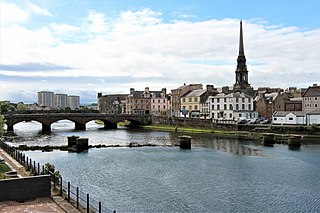
Ayr is a town situated on the southwest coast of Scotland. It is the administrative centre of the South Ayrshire council area and the historic county town of Ayrshire. With a population of 46,982 Ayr is the 16th largest settlement in Scotland and largest town in Ayrshire by population. The town is contiguous with the smaller town of Prestwick to the north.

Girvan is a burgh and harbour town in Carrick, South Ayrshire, Scotland. Girvan is situated on the east coast of the Firth of Clyde, with a population of about 6,450. It lies 21 miles (34 km) south of Ayr, and 29 miles (47 km) north of Stranraer, the main ferry port from Scotland to Northern Ireland.

Greenlaw is a town and civil parish situated in the foothills of the Lammermuir Hills on Blackadder Water at the junction of the A697 and the A6105 in the Scottish Borders area of Scotland. At the 2001 census, the parish had a population of 661.

Seagate Castle is a castle in North Ayrshire, in the town of Irvine, close to the River Irvine, Scotland. The castle was formerly a stronghold, a town house, and later a dower house of the Montgomery Clan. The castle overlooks the oldest street in Irvine, which was once the main route between the town and the old harbour at Seagatefoot, which by 1606, was useless and abandoned due to silting. The remains of the castle are protected as a scheduled ancient monument.

A tolbooth or town house was the main municipal building of a Scottish burgh, from medieval times until the 19th century. The tolbooth usually provided a council meeting chamber, a court house and a jail. The tolbooth was one of three essential features in a Scottish burgh, along with the mercat cross and the kirk (church).
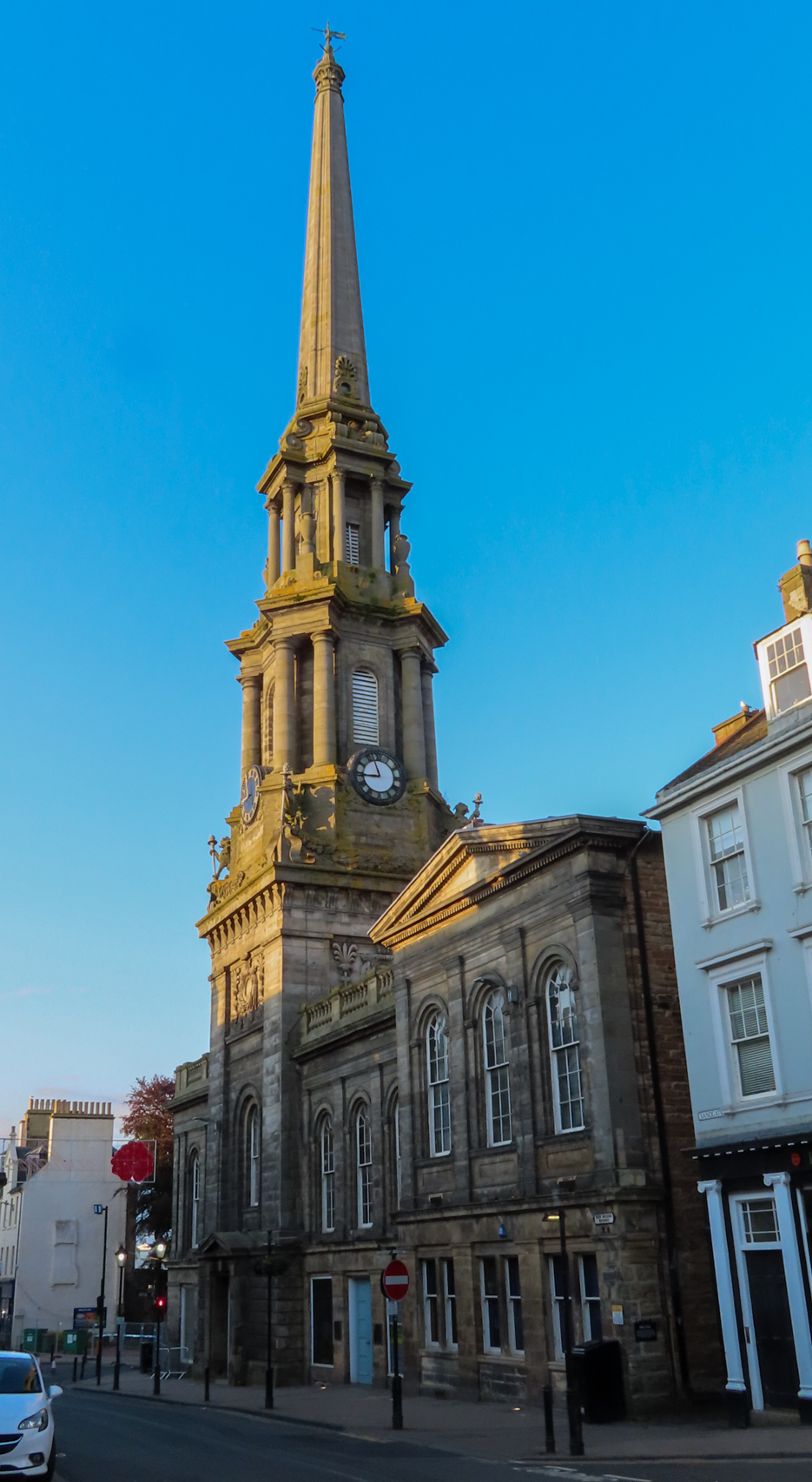
Ayr Town Hall is a municipal building in New Bridge Street, Ayr, Scotland. The town hall, which was the headquarters of Ayr Burgh Council, is a Category A listed building.

Kirkcudbright Tolbooth is a historic municipal building in Kirkcudbright in Dumfries and Galloway, Scotland. Built between 1627 and 1629 to serve the town as a centre of commercial administration, a meeting place for the council, and a prison, it was used for all these roles until the late eighteenth century when the council moved much of its business to new, larger premises they had constructed across the street; the tolbooth remained in use as a prison until the early nineteenth century, after which it remained in council ownership and was put to a variety of uses.
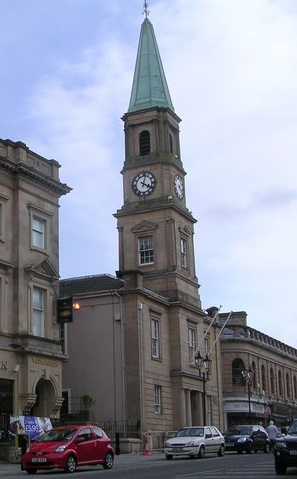
Airdie Town House is a municipal building in Bank Street, Airdrie, North Lanarkshire, Scotland. The town house, which was the headquarters of Airdrie Burgh Council, is a Category B listed building.

Irvine Townhouse is a municipal building in the High Street, Irvine, North Ayrshire, Scotland. The townhouse, which was the headquarters of Irvine Burgh Council, is a Category B listed building.

Prestwick Burgh Hall, also known as Prestwick Freeman's Hall and Prestwick Freemen's Hall, is a municipal building in Kirk Street, Prestwick, Scotland. The structure, which served as the meeting place of Prestwick Burgh Council, is a Category B listed building.
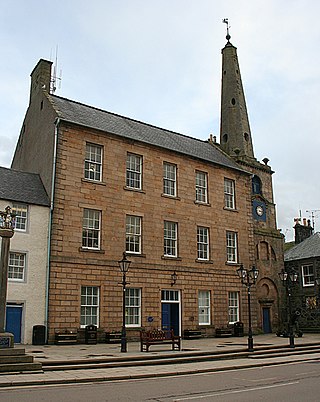
Banff Town House is a municipal building in Low Street, Banff, Aberdeenshire, Scotland. The building, which is used as a customer service point and job centre, forms part of a complex consisting of a steeple, completed in 1767, which is a Category A listed building, and a town house, completed in 1797, which is also a Category A listed building.
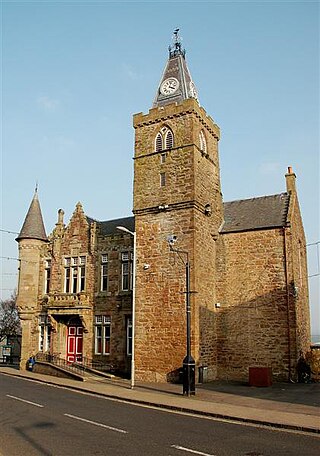
Maybole Town Hall is a municipal structure in the High Street in Maybole, South Ayrshire, Scotland. The structure, which is used as a community events venue, is a Category B listed building.

The Midsteeple is a municipal building in the High Street in Dumfries, Dumfries and Galloway, Scotland. The structure, which is used as a ticket office and a meeting place, is a Category A listed building.

The New Galloway Town Hall is a municipal building in Dumfries and Galloway, Scotland, situated on the town's high street. A tolbooth has existed on the site of the current building since at least 1711; in 1875, it was rebuilt and enlarged. In 1971 it was designated a Category B listed building.

Annan Town Hall is a municipal building in the High Street in Annan, Dumfries and Galloway, Scotland. The structure, which accommodates the local library and is also used as a venue for the provision of local services, is a Category B listed building.

Lochmaben Town Hall is a municipal building in the High Street in Lochmaben, Dumfries and Galloway, Scotland. The structure, which accommodates a library and a local customer services point, is a Category A listed building.

Dysart Tolbooth and Town House is a municipal building in the High Street, Dysart, Fife, Scotland. The structure, which was comprehensively restored in 2009, is a Category A listed building.

Newburgh Town House is a municipal building in the High Street in Newburgh, Fife, Scotland. The structure, which is used as a series of artists' studios, is a Category B listed building.





















